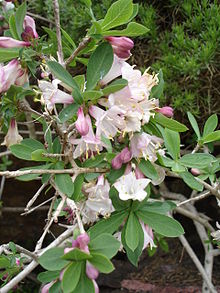Honeysuckle
| Honeysuckle | ||||||||||||
|---|---|---|---|---|---|---|---|---|---|---|---|---|

Winter honeysuckle ( Lonicera fragrantissima ) |
||||||||||||
| Systematics | ||||||||||||
|
||||||||||||
| Scientific name | ||||||||||||
| Lonicera | ||||||||||||
| L. |
The honeysuckle and honeysuckle ( Lonicera ) are a genus of flowering plants in the family of Honeysuckle (Caprifoliaceae). The 180 or so species are widespread in the northern hemisphere .
"Honeysuckle" is the name given to the shrubby growing species in which the flowers are in pairs. The berries that emerge from a pair of flowers are fused to form a double berry in some species (these species are also called double berries ). The lianas (with multi-flowered inflorescences ), on the other hand, are usually referred to as "honeysuckle", colloquially also as Jelängerjelieber .
description
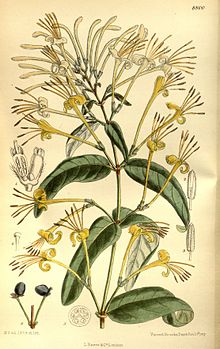

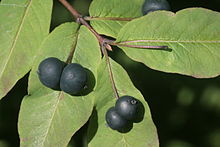
Appearance, buds and leaves
Lonicera species are evergreen or deciduous, woody plants that usually grow as shrubs or right- winding lianas , rarely as trees . The shoot axes are hollow in some species. The winter buds have one to a few pairs of rounded or pointed square bud scales, the inner ones sometimes growing further or bent back. Sometimes the terminal bud is reduced and replaced by two side buds.
The mostly opposite or rarely whorled leaves are stalked or sessile. The leaf blades are usually simple with whole or rarely toothed leaf margins. Stipules are usually missing.
Inflorescences and flowers
Often there are one or two pairs of small or deciduous bracts under the inflorescences . The lateral or terminal, sometimes on inflorescence stems, umbrella-clustered total inflorescences consist of opposite, sessile, zymous partial inflorescences that contain one to several flowers; sometimes the inflorescence is head-shaped. In some species, the inflorescence is reduced to a pair of flowers, rarely one or three flowers. in pairs in the leaf axils or in terminal cephalic inflorescences. The flowers stand over a pair of bracts , which are mostly free, sometimes more or less strongly overgrown and occasionally can enclose the ovary.
The hermaphrodite flowers are zygomorphic and usually five, rarely four-fold with a double flower envelope . The usually five, rarely four sepals are fused tubular or cup-shaped, sometimes truncated; sometimes there is a collar-like emergence at its base . The colors of the petals range from white to whitish to yellow and from reddish to purple-red, the color often changes when it fades. The usually five, rarely four petals are fused into a more or less long to very long, bell-shaped to funnel-shaped corolla tube. The crown ends with more or less regular four or five corolla lobes or two-lipped. If the crown is two-lipped, then the upper lip is four-lobed. After the bud has unfolded , the corolla tube is still closed and then looks club-shaped. The thickened part then splits into a single, downward pointing tip, which represents a lower lip, and four (in many species largely fused together) tips, which point upwards. The corolla tube is slightly to strongly curved on the underside towards the base, a spur is rarely present; there are compact, sessile nectar glands, sometimes in five even lines; rarely are they swollen at the base of the style.
There is a circle with five stamens . Usually two or three, rarely up to five carpels have become an under-earth, two to three, rarely up to fünfkammerigen ovary grown. If the flowers stand together in pairs, then the ovary may be partially or completely fused together (syngynium). The long and thin, hairy or bald stylus ends in a cephalic scar .
Fruits and seeds
The berries stand individually or in pairs as a double berry . The berries, which turn white, red, blue-black to black or green, sometimes frosted, contain one to many seeds when ripe. Sometimes the wrapper leaves grow to fruit ripeness and then envelop the double berries. The smooth, pitted or granular seeds have a lot of endosperm and a small, straight, rounded embryo .
ecology
The different species are adapted to moths (especially swarmers ), bumblebees , bees , wasps or hoverflies as pollinators ( entomophilia ).
Systematics and distribution
The genus Lonicera was established by L. 1753 in Species Plantarum . Lonicera caprifolium L. was established as the lectotype in 1913 by NL Britton and A. Brown. Homonyms are Lonicera Boehm. in Definitions Generum Plantarum ed. 3 Boehmer, 1760. 139, Lonicera Gaertn. in De Fructibus et Seminibus Plantarum ... , 1, 1788, p. 132, Lonicera Adans . in Familles des Plantes , 2, 1763, p. 157. Other synonym for Lonicera L. are: Xylosteon Mill. , Caprifolium Miller , Euchylia Dulac . The generic name Lonicera honors the German mathematician, doctor and botanist Adam Lonitzer (1528–1586) (Latinized as Lonicerus).
The genus Lonicera belongs to the tribe Caprifolieae within the family of Caprifoliaceae .
The genus Lonicera is widespread in the northern hemisphere . Lonicera species thrive mainly in the temperate areas . It occurs in North Africa , Eurasia and North America . About 57 species occur in China, 23 of them only there.
In Central Europe, the shrubs are Alpine honeysuckle ( Lonicera alpigena ), blue honeysuckle ( Lonicera caerulea ), black honeysuckle ( Lonicera nigra ), red honeysuckle ( Lonicera xylosteum ) and the lianas garden honeysuckle ( Lonicera caprifolium ) as well as forest honeysuckle ( Lonicera pericatlyet ). The shrub Tatar honeysuckle ( Lonicera tatarica ) is a neophyte in many areas of the temperate zones .








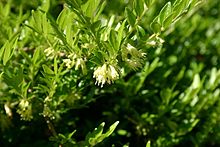

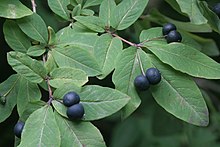




There are around 180 species worldwide; here is a selection:
- Evergreen Honeysuckle ( Lonicera acuminata Wall. , Syn .: Caprifolium fuchsioides (Hemsl.) Kuntze , Caprifolium henryi (Hemsl.) Kuntze , Lonicera acuminata var. Depilata P.S.Hsu & HJWang , Lonicera affinis Hook. & Arnott var. Angustifolia Hayata , Lonicera alseuosmoides Graebner , Lonicera apodantha Ohwi , Lonicera buddleioides P.S.Hsu & SCCheng , Lonicera fuchsioides Hemsl. , Lonicera giraldii Rehder , Lonicera henryi Hemsl. , Lonicera henryi var. angustifolia (Hayata) Ohwi , Lonicera henryi var. fulvovillosa Ohwi , Lonicera henryi var. setuligera WW Smith , Lonicera henryi var. Subcoriacea Rehder , Lonicera henryi var. Transarisanensis (Hayata) Yamamoto , Lonicera henryi var. Trichosepala Rehder , Lonicera pampaninii H.Lév. , Lonicera transarisanensis Hayata , Lonicera trichosepala (Rehder) PSHsu : This is evergreen Widely used in India , Bhutan , Nepal , Myanmar , China and the Philippines .
- Lonicera albiflora Torr. & A.Gray : It is widespread from the southern United States to northern Mexico and occurs in the states of Oklahoma , New Mexico , Texas , Arizona , Chihuahua , Coahuila, and Nuevo León .
- Alpine honeysuckle ( Lonicera alpigena L. ): It occurs in many areas with a moderate climate in Eurasia: in Germany , Austria , Switzerland , Italy , France , Spain , the former Yugoslavia and the former Czechoslovakia , Albania , Romania and Greece , also on the Kuril Islands and Sakhalin and on the Japanese islands of Hokkaidō and southern Honshū .
- Lonicera altmannii Regel & Schmalh. : It occurs in southeastern Kazakhstan , Kyrgyzstan and western Xinjiang .
- Lonicera angustifolia Wall. ex DC. (Syn .: Lonicera minutifolia Kitam., Lonicera myrtillus Hook. F. & Thomson ): This deciduous shrub comes with two varieties in Afghanistan , India , Pakistan , Bhutan , northern Myanmar , Nepal , Tibet and in the Chinese provinces of southwest Sichuan and Yunnan in front.
- Lonicera arborea Boiss. : This shrub or tree up to 9 meters high is found in Spain and northwest Africa .
- Lonicera biflora Desf. : It occurs in Morocco, Algeria and Spain.
- Lonicera bournei Hemsl. (Syn .: Caprifolium bournei (Hemsl.) Kuntze , Lonicera obscura Collett & Hemsl. ): It occurs in Myanmar and in the Chinese provinces of Guangxi and Yunnan.
- Lonicera buschiorum Pojark. : It occurs in the Caucasus and Georgia.
- Blue honeysuckle ( Lonicera caerulea L. , Syn .: Lonicera caerulea var. Altaica Pallas , Lonicera caerulea var. Edulis Turczaninow ex Herder , Lonicera caerulea var. Tangutica Maxim. , Xylosteon caeruleum (L.) Dumont de Courset ): This deciduous shrub is widespread in the northern hemisphere: China, Japan , Korea , Mongolia , Russia , Europe and North America.
- Lonicera calcarata Hemsl. : This liana thrives at altitudes of 1200 to 2500 meters in Tibet and in the Chinese provinces of Guangxi, southwest Guizhou , southwest Sichuan and Yunnan.
- Garden honeysuckle ( Lonicera caprifolium L. ): This liana is widespread in Europe: Norway , Sweden , Austria , Hungary , Poland , former Czechoslovakia , former Yugoslavia , Albania , Romania , Italy and Spain .
- Lonicera chrysantha Turcz. ex Ledeb. : This deciduous shrub is found in China, Japan, North Korea , Mongolia, Russia and Europe.
- Lonicera ciliosa (Pursh) Poir. ex DC. : This vine isnative towestern North America in southwestern British Columbia , northern Idaho , western Montana , Oregon , Washington, and western California .
- Lonicera cinerea Pojark. : It only occurs in Kazakhstan .
- Lonicera confusa (Sweet) DC. : It is common in Nepal, northern Vietnam and the Chinese provinces of Guangdong, Guangxi and Hainan.
- Lonicera crassifolia Batalin : It thrives at altitudes of mostly 900 to 1700, rarely up to 2300 meters in the Chinese provinces of Guizhou, southwestern Hubei , northwestern Hunan , Sichuan and Yunnan.
- Lonicera cyanocarpa Franch. : It occurs in Sikkim , Nepal, Tibet and in the Chinese provinces of Sichuan and Yunnan.
- Lonicera dasystyla Rehder : It occurs in Vietnam and in the Chinese provinces of Guangdong and Guangxi.
- Lonicera Elisae Franch. (Syn .: Caprifolium elisae (Franchet) Kuntze , Caprifolium praecox Kuntze , Lonicera infundibulum Franchet , Lonicera infundibulum . Var rockii Rehder , Lonicera pekinensis Rehder , Lonicera praecox (Kuntze) Rehder (1911) non K.Koch 1872 ): This deciduous shrub Thrives in forests and bushes at altitudes of 500 to 1,600 (up to 2,300) meters in the Chinese provinces of southwestern Anhui , southeastern Gansu, Hebei, Henan, western Hubei, southern Shaanxi , southern Shanxi , Sichuan and northwestern Zhejiang .
- Lonicera etrusca G.Santi : It iswidespreadin the Mediterranean .
- Lonicera fargesii Franch. : It thrives with two varieties at altitudes of 1600 to 2900 meters in the Chinese provinces of Chongqing , southern Gansu, western Henan, southern Shaanxi, Shanxi and Sichuan.
- Lonicera ferdinandi Franch. : It occurs in North Korea and thrives in large areas of China at altitudes of 200 to 2700 meters.
- Lonicera ferruginea Rehder : It iswidespreadin India, northern Thailand and China.
- Lonicera flava Sims : It is common in the USA.
- Fragrant honeysuckle ( Lonicera fragrantissima Lindl. & Paxton ): It thrives in two varieties at altitudes of 100 to 2700 meters in the Chinese provinces of Anhui, Gansu, Guizhou, Hebei, Henan, Hubei, Hunan, Jiangsu , Jiangxi , Shaanxi , Shandong , Shanxi , Sichuan and Zhejiang.
- Lonicera glutinosa Vis. (Syn .: Lonicera alpigena subsp. Glutinosa (Vis.) Kit Tan & Ziel. ): It occurs in Croatia and Montenegro.
- Lonicera gracilipes Miq. : It occurs in Japan on Honshu, Kyushu and Shikoku.
- Lonicera gynochlamydea Hemsl. : It thrives at altitudes of mostly 1200 to 1900, rarely up to 3000 meters in the Chinese provinces of Anhui, Chongqing , Gansu, Guizhou, Hubei, Hunan, Shaanxi, Sichuan and Yunnan.
- Lonicera hellenica Boiss. (Syn .: Lonicera alpigena subsp. Hellenica (Boiss.) Kit Tan & Ziel. ): It occurs in Greece and Turkey.
- Lonicera hildebrandiana Collett & Hemsl. : It is common in Myanmar, Thailand and the Chinese provinces of Guangxi and Yunnan.
- Lonicera hispida Pall. ex Roem. & Schult. (Syn .: Caprifolium hispidum (Pallas ex Roemer & Schultes) Kuntze , Lonicera anisocalyx Rehder , Lonicera chaetocarpa (Batalin ex Rehder) Rehder , Lonicera finitima W.W.Smith , Lonicera hispida var. Anisocalyx (Rehder) PKChou , Lonicera hispida var. Chaetocarpa Batalin ex Rehder , Lonicera hispida var. glabrata Batalin , Lonicera hispida var. hirsutior rule , Lonicera hispida var. setosa J.D.Hooker & Thomson , Lonicera montigena Rehder ): It is from Iran via Kazakhstan , Kyrgyzstan , Tajikistan to Russia and Pakistan ( Kashmir ) to Sikkim , Bhutan and Nepal and from Mongolia via Tibet to the Chinese provinces of Gansu, western Hebei, southern Ningxia, eastern Qinghai, southern Shaanxi, Shanxi, western Sichuan, northwestern Yunnan and northern Xinjiang are widespread.
- Lonicera humilis Kar. & Kir. : It is common in Afghanistan, Tajikistan, Kyrgyzstan, Kazakhstan and Xinjiang .
- Lonicera hypoglauca Miq. (Syn .: Lonicera affinis var. Hypoglauca . (Miq) Rehder , Lonicera affinis var. Mollissima Blume ex Maxim. , Lonicera affinis var. Pubescens Maxim. , Lonicera hypoglauca subsp. Nudiflora P.S.Hsu & HJWang , Lonicera rubropunctata Hayata ): it is Japan, Taiwan and China spread.
- Lonicera hypoleuca Decne. : It is common in Iran, Pakistan, Nepal and India.
- Curly honeysuckle ( Lonicera implexa Aiton ): It is widespread in the Mediterranean.
- Lonicera involucrata (Richardson) Banks ex Spreng. : It iswidespreadin North America from Alaska to northern Chihuahua .
- Japanese honeysuckle ( Lonicera japonica Thunb. ): The original homeland is Japan, Korea and China.
- Lonicera kabylica (Batt.) Rehder : It occurs in Algeria.
- Lonicera kansuensis (Batalin ex Rehder) Pojark. : It thrives at altitudes of 1,800 to 2,400 meters in the Chinese provinces of Gansu, Ningxia , Shaanxi and Sichuan.
- Lonicera kawakamii (Hayata) Masam. : It thrives in the mountains at altitudes of 3000 to 3900 meters only in Taiwan.
-
Lonicera ligustrina Wall. : Several varieties are common in India, Nepal, Bhutan and China:
- Lonicera ligustrina Wall. var. ligustrina : It is distributed in eastern India, Bhutan, Nepal and China.
- Evergreen creeping honeysuckle ( Lonicera ligustrina var. Pileata (Oliver) Franchet , Syn .: Lonicera pileata Oliv. ): This evergreen shrub is widespread in the Chinese provinces of Guangdong, Guangxi, Guizhou, western Hubei, Hunan, southern Shaanxi, Sichuan and Yunnan .
- Lonicera ligustrina var. Yunnanensis Franchet (Syn .: Lonicera nitida E. H. Wilson ): it is, spread southwestern Shaanxi, Sichuan and Yunnan in the Chinese provinces southern Gansu.
- Lonicera litangensis Batalin (Syn .: Lonicera farreri W.W.Smith , Lonicera oresbia W.W.Smith , Lonicera rockii Rehder ): It is widespread in Bhutan, Sikkim, Nepal, Tibet and in the Chinese provinces of Sichuan and Yunnan.
- Lonicera longiflora (Lindl.) DC. (Syn .: Lonicera longituba H.T.Chang ex PSHsu & HJWang ): It thrives at altitudes of 1200 to 1700 meters in the Chinese provinces of Guangdong, Guangxi, Hainan and Yunnan.
- Lonicera maackii (Rupr.) Maxim. : It iswidespreadin several varieties in China, Mongolia, Korea, Japan, and Russia's Far East .
- Lonicera macrantha (D.Don) Spreng. (Syn .: Caprifolium macranthum D.Don , Lonicera esquirolii H.Lév. , Lonicera fulvotomentosa P.S.Hsu & SCCheng , Lonicera guillonii H.Lév. & Vaniot , Lonicera hirtiflora Champion ex Bentham , Lonicera inodora W.W.Sm. , Lonicera macrantha var. Calvescens Chun & FCHow , Lonicera calvescens (Chun & FCHow) PSHsu & HJWang , Lonicera macranthoides Hand.-Mazz. , Lonicera strigosiflora C.Y.Wu ex XWLi ): It is common in India, Bhutan, Nepal, Myanmar, Vietnam, Taiwan and China.
- Lonicera maximowiczii (Rupr.) Rule : It is common in Russia's Far East , Korea, and the Chinese provinces of Heilongjiang and Jilin .
- Lonicera mexicana (Kunth) Rehder : The home is Mexico.
- Lonicera microphylla Willd. ex Schult. (Syn .: Lonicera oiwakensis Hayata ): It is in Russia, Iran, Kazakhstan, Kyrgyzstan, Tajikistan, Afghanistan, Pakistan, northwest India, Mongolia, Inner Mongolia , Tibet, Taiwan and the Chinese provinces Gansu, western Hebei, Ningxia, Qinghai, Shanxi as well as Xinjiang and perhaps Henan are widely used.
- Lonicera minutifolia Kitam. : The home is Nepal.
- Lonicera modesta Rehder : It thrives at altitudes of 500 to 1700 meters in the Chinese provinces of Anhui, southeastern Gansu, western Henan, Hubei, Hunan, Jiangxi, southern Shaanxi, Zhejiang and perhaps Fujian.
- Lonicera mucronata Rehder : It thrives at altitudes of 800 to 1500 meters only in the Chinese provinces of Hubei and Sichuan.
- Lonicera nervosa Maxim. : It thrives at altitudes of 2100 to 4000 meters in the north-western Chinese provinces of Gansu, western Henan, Ningxia, Qinghai, Shaanxi, southern Shanxi and Sichuan.
- Black honeysuckle ( Lonicera nigra L. , Syn .: Lonicera acrophila H.Lév. , Lonicera barbinervis Kom. , Lonicera decipiens Hook. F. & Thomson , Lonicera lanceolata Wall. ): It is in Europe, India, Bhutan, Nepal, Korea , widespread in Tibet and the Chinese provinces of western Anhui, northeastern Guizhou, western Hubei, Jilin, Sichuan as well as Yunnan.
- Lonicera nummulariifolia Jaub. & Spach : It occurs in Greece, Crete, Turkey, Syria, Lebanon and Libya.
- Lonicera oblata K.S.Hao ex PSHsu & HJWang : This endemic thrives on stony slopes at altitudes of around 1200 meters only in Neiqiu in the Chinese province of Hebei.
- Lonicera oreodoxa Harry Sm. Ex Rehder : It only thrives at higher altitudes between 4700 and 4800 meters only in northern Sichuan.
- Lonicera pallasii Ledeb. (Syn .: Lonicera caerulea var. Pallasii (Ledeb.) Cinovskis ): It is distributed from southeastern Sweden , Estonia and Latvia and in Russia to Siberia.
- Forest honeysuckle ( Lonicera periclymenum L. ): It is widespread in southwest, western and central Europe as well as in Morocco .
- Lonicera pilosa Willd. ex Kunth : It was first described from Mexico.
- Lonicera praeflorens Batalin : It is common in China, Korea, Japan and in Russia's Far East.
- Lonicera prolifera (Kirchner) Booth ex Rehder : It was described from North America.
-
Lonicera pyrenaica L .: There are two subspecies:
- Lonicera pyrenaica subsp. majoricensis (Gand.) Browicz : This endemic occurs only on Mallorca.
- Lonicera pyrenaica L. subsp. pyrenaica : It occurs in Spain, Andorra, France and Morocco.
- Lonicera retusa Franch. (Syn .: Lonicera kachkarovii (Batalin) Rehder , Lonicera limprichtii Pax & K.Hoffmann , Lonicera orientalis var. Kachkarovii Batalin ): It grows at altitudes from 2,000 to 3,300 meters in the southern Chinese provinces of Gansu, southern Shaanxi, Shanxi southwestern and western Sichuan.
- Lonicera rupicola Hook. f. & Thomson (Syn .: Lonicera thibetica Bureau & Franchet , Lonicera syringantha Maxim. , Lonicera codonantha Rehder , Lonicera syringantha var. Minor Maxim. , Lonicera wolfii (Rehder) KSHao , Lonicera minuta Batalin ): This mostly deciduous shrub comes from China, Bhutan , Nepal and India.
- Lonicera ruprechtiana rule (Syn .: Caprifolium ruprechtianum (usually) Kuntze , Lonicera brevisepala P.S.Hsu & HJWang , Lonicera chrysantha var. Subtomentosa (Ruprecht) Maxim. , Lonicera ruprechtiana var. Lanceolata Skvortsov , Lonicera ruprechtiana var. Xanthocarpa Zabel , Xylosteon gibbiflorum Ruprecht & Maxim. Var. Subtomentosum Ruprecht ): This deciduous shrub occurs in Heilongjiang, Jilin, Liaoning and in northern Korea and Russia.
- Lonicera semenovii rule : It occurs in Afghanistan, Iran, Kazakhstan, Kyrgyzstan, Kashmir, Tibet and Xinjiang.
- Lonicera sempervirens L .: The home is Canada and the USA.
- Lonicera setifera Franch. : It occurs in India, Tibet and in the Chinese provinces of Sichuan and Yunnan.
- Lonicera similis Hemsl. (Syn .: Caprifolium simile (Hemsl.) Kuntze , Lonicera buchananii Lace , Lonicera delavayi Franchet , Lonicera macrantha var. Biflora Collett & Hemsl. , Lonicera macrantha var. Heterotricha P.S.Hsu & HJWang , Lonicera macranthoides Handel-Mazzetti var. Heterotricha (PSHsu & HJWang) BKZhou , Lonicera omeiensis (PSHsu & HJWang) BKZhou , Lonicera similis var. Delavayi (Franchet) Rehder , Lonicera similis var. Omeiensis P.S.Hsu & HJWang ): It occurs in China and Myanmar.
- Lonicera spinosa Jacq. ex Walp. (Syn .: Lonicera albertii rule ): This deciduous shrub is widespread in Xinjiang, Tibet, Afghanistan, India, Kashmir, Kazakhstan, Kyrgyzstan and Tajikistan.
- Lonicera splendida Boiss. : It occurs in Spain.
- Lonicera stabiana Pasq. : It occurs in Italy.
- Lonicera stephanocarpa Franch. : It is common in the Chinese provinces of Gansu, Ningxia, Shaanxi and Sichuan.
- Lonicera subaequalis Rehder (Syn .: Lonicera carnosifolia C.Y.Wu ex PSHsu & HJWang ): This liana thrives on shady in mountain forests at altitudes of 1500 to 2500 meters in the Chinese provinces of Guizhou and Sichuan.
- Lonicera subhispida Nakai : It is common in Korea, Russia and China.
- Lonicera subspicata Hook. & Arn. : The home is California.
- Lilac-blossomed honeysuckle ( Lonicera syringantha Maxim. , Syn .: Lonicera rupicola subsp. Syringantha (Maxim.) Zabel ): The home is Bhutan and China.
- Lonicera tangutica Maxim. : The homeland is Bhutan, Nepal, Sikkim and China.
- Tatar honeysuckle ( Lonicera tatarica L. ): The distribution area ranges from Eastern European Russia to Central Asia, Siberia and China.
- Lonicera tatarinowii Maxim. (Syn .: Lonicera leptantha Rehder , Lonicera tatarinowii var. Leptantha (Rehder) Nakai. ): It thrives at altitudes of 400 to 1800 meters in the Chinese provinces of northwestern Hebei, Liaoning, eastern Shandong and perhaps Henan as well as in Inner Mongolia.
- Lonicera tomentella Hook. f. & Thomson : The home is Bhutan, Nepal, Sikkim and China (Xizang, Yunnan).
- Lonicera tragophylla Hemsl. (Syn .: Lonicera harmsii Graebner ): It thrives at altitudes of mostly 1000 to 2000 (700 to 3000 meters in the Chinese provinces of Anhui, southern Gansu, northern Guizhou, southwestern Hebei, northwestern Henan, Hubei, southern Ningxia, Shaanxi, southern Shanxi , Sichuan and Zhejiang).
- Lonicera trichosantha Bureau & Franch. : The home is China.
- Lonicera tubuliflora Rehder : It only thrives in Sichuan at altitudes of 2100 to 3100 meters.
- Lonicera virgultorum W.W.Sm. : It only occurs in Yunnan.
- Lonicera webbiana Wall. ex DC. (Syn .: Lonicera adenophora Franch. , Lonicera alpigena var. Phaeantha Rehder , Lonicera hemsleyana (Kuntze) Rehder , Lonicera heteroloba Batalin , Lonicera heterophylla Decaisne , Lonicera heterophylla var. Karelinii (Bunge ex Kirilov) Rehder , Lonicera jilongensis P.S.Hsu & HJWang , Lonicera karelinii Bunge ex Kirilov , Lonicera mupinensis Rehder , Lonicera perulata Rehder , Lonicera tatsienensis Franch. , Lonicera webbiana var. Lanpingensis Y.C. Tang , Lonicera webbiana var. Mupinensis (Rehder) PSHsu & HJWan ): She is Afghanistan, Kashmir, Pakistan, Afghanistan Nepal, Bhutan, Myanmar, Tibet and the Chinese provinces, southern Gansu, western Hubei, Jiangxi, southern Ningxia, eastern Qinghai, southern Shaanxi, Shanxi, Sichuan and northwestern Yunnan are widespread.
- Red honeysuckle ( Lonicera xylosteum L. ): It is widespread in Eurasia.
- Lonicera yunnanensis Franch. (Syn .: Lonicera ciliosissima C.Y.Wu ex PSHsu & HJWang , Lonicera mairei H.Lév. , Lonicera yunnanensis var. Linearifolia C.Y.Wu ex XWLi , Lonicera yunnanensis var. Tenuis Rehder ): It only thrives at altitudes of 1700 to 3000 meters Chinese provinces of southwest Sichuan and northwest Yunnan.
use
Some species and varieties are used as ornamental plants in parks and gardens.
Commonly planted species and hybrids are:
- Evergreen honeysuckle ( Lonicera acuminata Wall. )
- Lonicera ciliosa (Pursh) Poir. ex DC. (orange blossoming liana)
- Maibeere ( Lonicera caerulea var. Kamtschatica Sevast. , Syn .: Lonicera kamtschatica (Sevast.) Pojark. )
- Winter honeysuckle ( Lonicera fragrantissima Lindl. & Paxton ): It is native to China. (white flowering, deciduous shrub)
- Lonicera × heckrottii Osborn (compact growing liana)
- Evergreen creeping honeysuckle ( Lonicera ligustrina var. Pileata (Oliv.) Franchet , Syn .: Lonicera pileata Oliv. ) (Low evergreen shrub)
- Hedge myrtle ( Lonicera ligustrina var. Yunnanensis (Franch.) PSHsu & HJWang , Syn .: Lonicera nitida E.H.Wilson )
- Golden honeysuckle ( Lonicera × tellmanniana Magyar ex HLSpäth ) (lush yellow- orange blooming , compact climbing plant)
swell
literature
- Qiner Yang, Sven Landrein, Joanna Osborne, Renata Borosova: Caprifoliaceae. In: Wu Zheng-yi, Peter H. Raven, Deyuan Hong (Eds.): Flora of China . Volume 23: Acoraceae through Cyperaceae . Science Press / Missouri Botanical Garden Press, Beijing / St. Louis 2010, ISBN 978-1-930723-99-3 , Lonicera , pp. 620-640 (English, online ). (Sections Description, Systematics and Distribution)
- Rubina Akhtar Rafiq: Flora of Pakistan 174: Caprifoliaceae. Department of Botany, University of Karachi, Karachi 1986, pp. 11-32 ( http://www.efloras.org/florataxon.aspx?flora_id=5&taxon_id=118877 online).
- Harry Garms: Plants and Animals of Europe. Paperback edition. dtv, Munich 1969, ISBN 3-423-03013-5 .
- Hermann Meusel, Rudolf Schubert (Ed.): Excursion flora for the areas of the GDR and the FRG. Founded by Werner Rothmaler. 7th ("1st") heavily revised and supplemented edition. Volume 2: Vascular Plants , People and Knowledge, Berlin 1972.
- Kazimierz Browicz : Lonicera L. In: TG Tutin, VH Heywood, NA Burges, DM Moore, DH Valentine, SM Walters, DA Webb (eds.): Flora Europaea . Volume 4: Plantaginaceae to Compositae (and Rubiaceae) . Cambridge University Press, Cambridge 1976, ISBN 0-521-08717-1 , pp. 46-48 (English).
Individual evidence
- ↑ Carl von Linné: Species Plantarum. Volume 1, Lars Salvius, Stockholm 1753, p. 173 ( digitized version ).
- ↑ Nathaniel Lord Britton, Addison Brown: An illustrated flora of the northern United States, Canada and the British possessions: from Newfoundland to the parallel of the southern boundary of Virginia, and from the Atlantic Ocean westward to the 102d meridian. 2nd edition, Volume 3, C. Scribner's sons, New York 1913, p. 277. Digitized
- ^ Lonicera at Tropicos.org. Missouri Botanical Garden, St. Louis
- ↑ Lotte Burkhardt: Directory of eponymous plant names . Extended Edition. Botanic Garden and Botanical Museum Berlin, Free University Berlin Berlin 2018. [1]
- ↑ a b c d e f g h i j k l m n o p q r s t u v w x y z aa ab ac ad ae af ag ah ai aj ak al am an ao ap aq ar as at au av aw Qiner Yang, Sven Landrein, Joanna Osborne, Renata Borosova: Caprifoliaceae. In: Wu Zheng-yi, Peter H. Raven, Deyuan Hong (Eds.): Flora of China . Volume 23: Acoraceae through Cyperaceae . Science Press / Missouri Botanical Garden Press, Beijing / St. Louis 2010, ISBN 978-1-930723-99-3 , Lonicera , pp. 620-640 (English, online ).
- ↑ a b c d e f g h i j E. von Raab-Straube (2017+): Caprifoliaceae. - In: Euro + Med Plantbase - the information resource for Euro-Mediterranean plant diversity. Datasheet Caprifoliaceae
- ↑ a b c d e f g h i j k l m n o p q r s Lonicera in the Germplasm Resources Information Network (GRIN), USDA , ARS , National Genetic Resources Program. National Germplasm Resources Laboratory, Beltsville, Maryland.
- ↑ a b Werner Greuter , Hervé-Maurice Burdet , Guy Long (eds.): Med Checklist. A critical inventory of vascular plants of the circum-Mediterranean countries . Vol. 1: Pteridophyta (ed. 2), Gymnospermae, Dicotyledones (Acanthaceae - Cneoraceae) . Conservatoire et Jardin Botanique, Genève 1984, ISBN 2-8277-0151-0 ( online ).
- ↑ a b German name after Andreas Roloff, Andreas Bärtels: Flora of the woods. Purpose, properties and use . 3rd, corrected edition. Eugen Ulmer, Stuttgart (Hohenheim) 2008, ISBN 978-3-8001-5614-6 , pp. 376-393 .
- ^ T. Ruíz Téllez, Juan Antonio Devesa: Lonicera . In: Santiago Castroviejo, Juan Antonio Devesa, Raul Gonzalo, Alberto Herrero (eds.): Flora Ibérica. Plantas Vasculares de la Península Ibérica e Islas Baleares . Vol. XV. Rubiaceae - Dipsacaceae . Real Jardín Botánico, CSIC, Madrid 2007, ISBN 978-84-00-08567-4 , p. 168-190 ( PDF file ).




